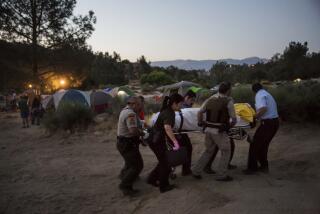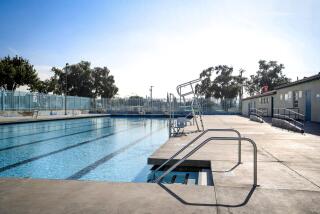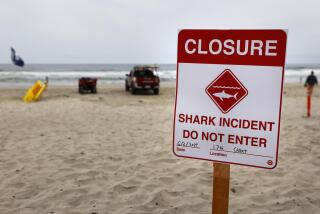Swimming Pool Safety : Safeguarding Your Children Against Back-Yard Injury
- Share via
The two recent near-drownings in the San Fernando Valley illustrate the dangers of inadequate safety measures at residential swimming pools. Both cases were examples of what often occurs: children can drown or nearly-drown in only a few minutes without adequate supervision.
Most parents probably don’t realize the majority of drownings occur when a child is last seen in the house or other area of the yard--nowhere near the pool. For this reason, health officials stress isolating the pool from the rest of the yard with “barrier” fencing and other safety measures.
Many drowning victims are children under 5--in some states drowning is the leading cause of death for this age group--and in California about 100 children a year drown in their own pools. But older children and those who know how to swim are not immune. Statistics show 25% of all childhood drowning victims have had swimming lessons.
A statewide emergency regulation put into effect in February requires barriers between house and pool. In the Valley, when a new pool is built, a city Department of Building and Safety inspector visits the site to ensure proper fencing has been installed.
Drowning Statistics
There were 17 drowning deaths in the Valley in 1993. Nearly 25% of drowning victims last year in Los Angeles County were under 5 years of age:
1992 1993 1994* Deaths 143 134 49 0-4-year-olds 21 35 7**
* As of June 23 ** 0-5-year-olds
Safeguarding the Pool Health officials recommend “layers” of protection to prevent pool injuries.
Fencing: Should be at least 4 feet high and made of chain link, wood, wrought iron or masonry. The county department of health recommends height of 5 feet, preferably of wrought iron bars no wider than 3 inches apart.
Self-latching gate: Latch should be at least 4 feet, 10 inches above ground, with latche on inside of fence, facing pool.
Automatic pool cover: Should be ASTM-approved (American Society of Standards and Materials) and motorized, in which cover is attached by runners to cement, making it difficult for children to fall in.
Alarm: Install on doors and windows leading to pool.
Rescue equipment: Life preserver rings, life jackets and shepherd’s crook should be kept poolside. Inflatable toys should not be considered as drowning prevention.
Cordless phone: Kept near pool for emergencies, with numbers posted.
Supervision: Children under 12 should be supervised by an adult who knows how to swim and lifesaving techniques. There should always be a caretaker or guardian present who also knows CPR. The American Red Cross offers CPR classes; call 376-1700.
Swimming lessons: City Dept. of Recreation and Parks recommends and provides lessons throughout the Valley for children beginning at age 3. The American Academy of Pediatrics says lessons for children under 4 may lead to false sense of security. For locations recreation centers where private and group lessons are offered, call Valley Region Aquatics at 765-0284.
Basic Rescue
The American Red Cross recommends “Reach or throw, don’t go” when a child is in danger in a pool.
Reaching assist: If able to reach, use a long object such as oar, paddle, tree branch, towel, etc. Keeping weight low, lean away from victim, lying down or standing with legs bent and feet comfortably spread. Slowly bring victim in, using hand-over-hand grasp on the reaching object.
Throwing assist: Using throwing device such as ring buoy, stay out of the water and stand with one foot forward and one back, keeping weight low. Hold device in dominant hand and hold extra line in other hand. Use underhand toss, aiming device just beyond victim.Enter the water only after above options have been attempted.
What it Costs
The average cost of adding safety precautions to a 20-by-40-foot residential in-ground pool in California:
Pool: $20,000 Four-sided fencing: $2,094
Gate: $136
Power pool cover: $6,000
Total: $28,230
Sources: American Red Cross; Los Angeles City Dept. of Recreation & Parks; Los Angeles County Dept. of Health Services; Research by JULIE SHEER/Los Angeles Times
More to Read
Sign up for Essential California
The most important California stories and recommendations in your inbox every morning.
You may occasionally receive promotional content from the Los Angeles Times.










